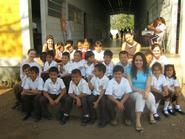
During the 2006 spring break, four Hamilton women made the journey to Cofradia, Honduras, for a service-learning project at San Jeronimo Bilingual School (SJBS). With the suggestion and much help from current volunteer teacher at San Jeronimo, Lauren Fisher '05, students Sarah Griffith '06, Emily Gunther '06, Johanna Sanchez '08, and Julia Daly '08 created the pilot trip for the international service-learning trip, Hamiltonians in Honduras. In Cofradia, the girls not only worked on art, reading, and athletic activities with some of SJBS's 150 students, but they painted the concrete library, organized and coded hundreds of books, and made picture dictionaries for Lauren's first-grade class.
The BECA Mission
With much help from Jaime Tackett Koppel '98, San Jeronimo Bilingual School, in Cofradia, Cortes, Honduras, opened in September 2004. The school is operated through an important partnership with the Parents Association (Asociacion de Padres de Cofradia) and Bilingual Education for Central America (BECA). BECA is a U.S. based non-profit 501(c)(3) grassroots organization focused on sustainable, inexpensive bilingual education in Central America. The foundation supports San Jeronimo by recruiting and supporting a qualified group of volunteer teachers. The organization thrives on its collaboration between the nine English-speaking volunteers and the Honduran teachers, parents, administrators and students. When threatened with closing two years ago, the parents in Cofradia built the concrete school in just three months, while Jaime Tackett Koppel recruited volunteers. Today, the parents' association maintains responsibility for operating the school, which includes SJBS's basic funding and growth decisions. While many of the families pay as little as $5 or $10 a month, about one-third of the children are on scholarships provided by BECA so that the school's population represents a cross section of Cofradia's economic classes.
The Students and the School
 |
| Sarah Griffith '06 with 2nd graders |
Hamiltonians in Honduras
Past and present Hamiltonians have the resources and potential to stay involved as a part of the SJBS community. The cultural exchange that takes place between San Jeronimo's volunteer teachers and its Honduran students can also happen with Hamilton students. Current Hamilton students can learn more about the school and Honduran culture while putting theory into practice. Hamilton students have the time, energy and drive to apply what they learn in the classroom to real life experience. Educational inequality, pedagogy, poverty and Hispanic culture are only a few of the themes Hamilton students will experience first-hand on this trip. Personal, voluntary support is often more important than monetary contributions. At the same time, Hamilton as an institution has the resources to support the volunteers and their projects. Even a few hundred U.S. dollars could buy enough paint in Honduras to renovate a classroom or paint a mural on the school's back wall. The school's card catalog was established for less than the cost of a campus parking ticket. The interactions and perceptions between Hondurans and foreigners are about personal connections and giving back to the community, rather than about the money. Still, Hamilton has resources they do not, and the ability and desire to help in a constructive way. This project's future could potentially connect Hamilton students and alumni as well as students in Honduras in a web that reaches from Clinton to Cofradia and give an irreplaceable education to all those involved.
Sources: becaschools.org
Written by: Emily Gunther '06, Sarah Griffith '06
Posted March 29, 2006
